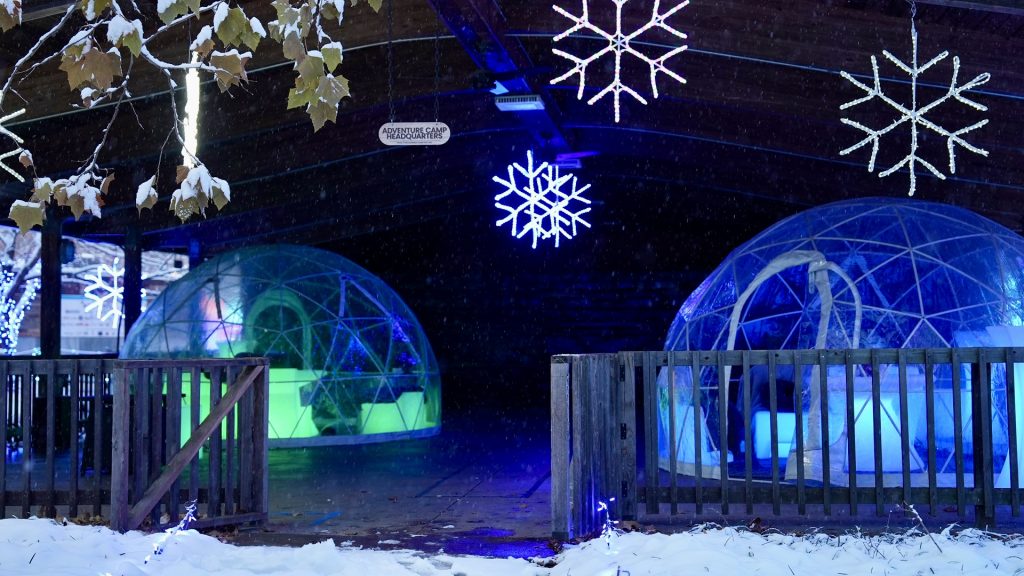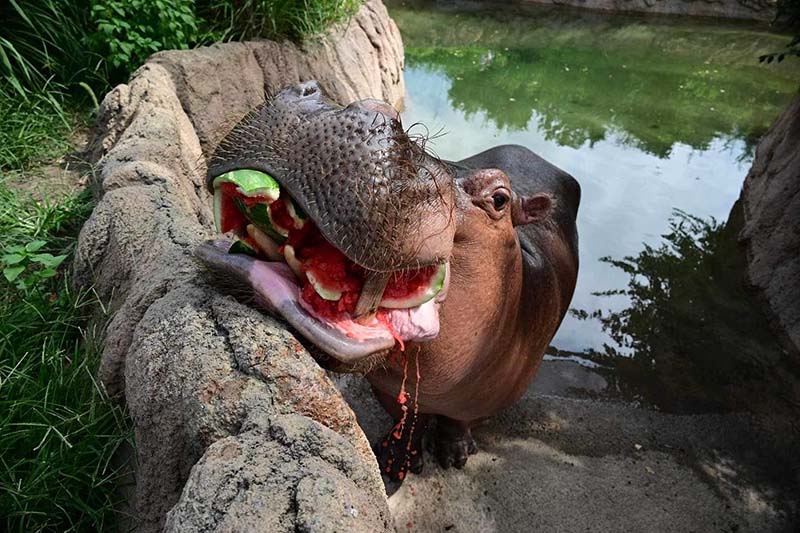Conservation in Action at the Topeka Zoo and Conservation Center
Written by Shari LaRue, Docent
Conservation is in our name, Topeka Zoo and Conservation Center. So, what is conservation and what does the Zoo do that made it important to us to include it in our name? According to Merriam Dictionary, “Conservation is a careful preservation and protection of something; especially planned management of a natural resource to prevent exploitation, destruction or neglect. “ For the rest of this year, I will be writing articles for Zooreka to discuss conservation initiatives we are involved in. This month we will look at what is done for conservation in the Zoo. Discussions about animal conservation, working out in the field and the numerous national and worldwide conservation efforts we are involved in will also be in an article later this year.
Educating the public about conservation initiatives and creating a bond between people, nature and the environment is what the Zoo education staff provides. The education staff stay busy working with children in the numerous camps that provided at the Zoo. There are spring, summer, teen and winter Camp for children interested in learning about animals. There is also a Middle School and High School Eco Club, Topeka Zoo youth council and Teen ecotourism program. The staff also conduct evening conservation education events, educating through our Discovery Home School class, in-person or virtual programs and educating participant in our Citizen Science projects.
In addition, the education department staff, Dennis Dinwiddie, Rachael Rost and Erin Paquette coordinate and participate in numerous education days throughout the year. These include Pollinator Palooza, Earth Day, Ocean’s day, Global Tiger Day, World Elephant Day, World Lion Day, Eagle Day and World Orangutan Day. They also run an annual writing contest for people of all ages to use their voice to speak up for threatened and endangered species around the world. Every year, thousands participate in the educational programs provided by the Zoo’s education staff, with hundreds of programs offered.
The Director of Education, Dennis Dinwiddie provides a 40-hour educational class for new Docents and helps with providing on-going educational support for all the Docents that have graduated in previous years. The Docents then provide education to our guests throughout the year. The Zoo’s Discovery Stations provide animal artifacts and other interesting items that we use to educate, and we provide information about the animals at our Zoo. We also support the Education Department in all the numerous education days that the Zoo offers. As of the end of February 2021 Docents have worked 529 hours helping at the Zoo. In 2020 (the year of COVID), we worked 7,605 hours and in 2019 we spent 9,791 hours working at the Zoo. If you would like to know more about any of the programs mentioned, go to our website at: https://topekazoo.org and click on the Education tab at the top of the webpage.
Pollinator Palooza is one of the biggest events for funding our conservation efforts. Each year we provide an opportunity for the community to purchase native plants, bird and bee houses to expand habitat for area pollinators. This native plant sale held on May 8, 2021 and will include a few new varieties. Rick Knight, our horticulturist tells me that we will be adding, Bush’s poppy mallow, Prairie phlox, Prairie smoke geum, Lead plant, Ox eye sunflower, Elm lead goldenrod and Yellow giant hyssop. The new variety of sunflower is more compact than the willow leaf we sell. Rick says if you have limited space for a pollinator garden; choose a milkweed, a sunflower and an Aster. They are great for the pollinators. In 2020, we sold 1,792 native flowering plants to support monarch butterflies and other pollinators. There were 27 different varieties of plants last year and we are expanding that this year. Last year we sold 1,792 native flowering plants to support monarch butterflies and other pollinators. This year there will be more flats of plants and a greater variety.
Speaking of horticulture, our horticulturists Rick and Joe do a superb job of providing the Zoo with plants that support pollinators. We have 14-pollinator bed with 6,383 square feet of plantings to support pollinators within the Zoo. We have added 36,000 more square feet of plantings with native flowers, grasses and forbs along with over seeding in the in the storm water control system and drainage swale. Rick tells me that he takes note of what pollinators are attracted to in the prairie and then tries to bring those plants that attract a wide range of bees and butterflies to the Zoo’s gardens. We also have our own beehives and our bees benefit from all the plantings at the Zoo. You will see sunflowers, asters, compass plants and milkweeds plantings because the pollinators love them and they do not require much care or water. Drought tolerant plants used in the Zoo flower gardens to conserve water yet provide beauty to our guests and pollen for our pollinators.
All new trees and shrubs planted at the Zoo are watered routinely for the first year after planting to give them a good start, after that they are on their own. We try to conserve water in the types of plants and trees that are used and by adding lots of woodchip mulch obtained from the tree trimming done at the Zoo. It keeps the roots cool, keeps moisture in and holds down the weeds. Very little chemical control is used for weeds or insects. The exception is controlling bagworm in the evergreens. Rick says he uses as little as possible and times it well for effectiveness. In the rainforest, Rick and Joe introduced beneficial insects and that works until the birds find out. Otherwise, an organic mix is used for aphids and mealybugs.
The Zoo composts just about everything that comes from the Zoo grounds. Dead plants, leaves, grasses are all composted in the back of the Zoo. It is used in all the flowerbeds, around new shrubs and tree plantings, in the rainforest, in new yards and in ground cover beds. It is an all-plant compost, as the herbivore animal waste is taken to Garick located at I-70 and MacVicar where it is composted.
Rick reuses materials from one place to another so that nothing goes to waste. Rocks, bricks, pots, lumber are stored in a service area and are used when needed. In addition, the lawns are a mix of cool season grasses, warm season grass and you will find a few weeds. What some view as a weed such as dandelions are welcomed because the bees love them. If you smell fresh honey from our bees (sold in our gift shop) and smell a dandelion, they smell the same. We also have areas of landscape just for the bees with tall, sweet clover that you will see in the bear habitat. The bees get the clover and the bears get some honey treats.
The Zoo recycles all scrap metals with the money received from recycling going toward our conservation efforts. Just as is the money we receive from the coin feeders that provide guests the opportunity to feed the waterfowl. Money contributed by our guests by rounding up their purchases at admissions, concession, and gift shop is an additional way you help the zoo with its mission. Throughout the rest of this year, I will be writing about just how much money the Topeka Zoo contributes to various conservation efforts each year, what we are doing for the many threatened and endangered animals in the world, and what we are doing in the field for local conservation efforts. I think you will be amazed!
Our Guest services also keeps conservation efforts alive at the Zoo in many ways. The purchasing of supplies is done with conservation in mind. That is why you will not find Styrofoam products or plastic straws or lids at the concession stand. It is an effort to eliminate single use plastics or one time use.
If you attend Earth Day on April 17th, you’ll have the opportunity to learn much more about the problem that single use plastics is creating in our environment.
Office produces and supplies purchased are from recycled products. Any paper document that is digitalized or scanned into our system is then shredded and recycled. Deposits made from our registers will soon be using plastic envelopes that are reusable. All Zoo staff makes every effort to turn off equipment and lights when a space is not in used. All food items are reviewed to ensure that only products that use sustainable palm oil are purchased. Guest services makes every effort to buy in bulk to decrease the amount of packing materials that are used. The plush toys that are purchased for the gift shop are made with recycled materials.
As you walk through the Zoo, you will find a cell phone recycle area inside Liana’s Forest, where the Orangutans are. You will also find on the north fence a recycle center for fishing lines. As you probably already know, we ask the community to recycle their clean Christmas Trees by bringing them to the Zoo each year. They are used as enrichment for the animals and put to good use. When we trim the rainforest, any tree trimmings that are in the diet plan an animal receives with the remainder being composted. Even some of the fruits that are produced in the rainforest (bananas, breadfruit) are given to the animals. The Zoo makes every effort to reduce, reuse or recycle as many things as possible.
I have a reminder to end with. Please put May 8 on your calendar and come out and support Pollinator Palooza by purchasing native plants and adding them to your garden to support butterflies, bees and other pollinators. There will be a great variety of plants with some that bloom in each season, Spring, Summer and Fall. We will have individuals that can help you with any questions you might have. Therefore, I hope to see you on May 8th.



